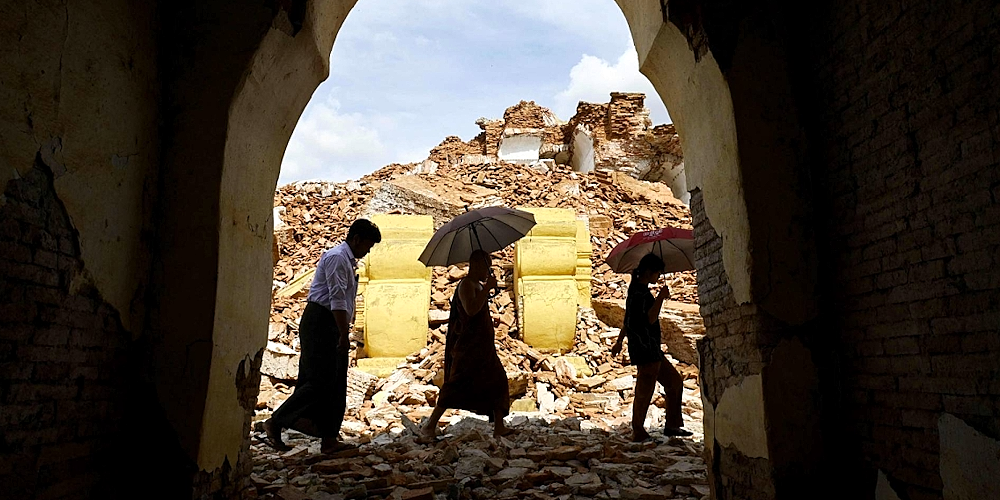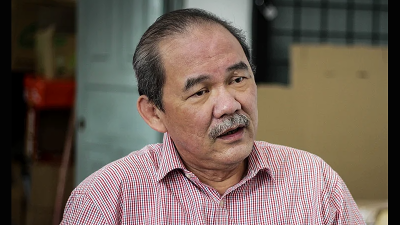The devastating 7.7-magnitude earthquake on March 28 has exacerbated an already dire humanitarian situation in Myanmar.
According to the United States Geological Survey (USGS), the death toll could surpass 10,000, with 15.2 million people affected, critically requiring temporary shelter, water, sanitation, medical support and food.
The United Nations highlighted that even before this latest tragedy, a significant portion of Myanmar’s population needed assistance, and the earthquake risks will further erode the resilience of communities already struggling with conflict, poverty and past disasters.
Myanmar, much like Indonesia, is highly susceptible to natural disasters, situated on a seismically active fault line.
The recent earthquake is a stark reminder of the region’s vulnerability to such events.
Exactly 20 years prior, on March 28, 2005, an 8.7-magnitude earthquake ravaged the Nias and Simeulue Islands of Aceh, Indonesia.
This was a major aftershock of the catastrophic 9.3-magnitude earthquake and subsequent tsunami that struck Aceh on Dec. 26, 2004, causing widespread devastation across the Indian Ocean.
The year after, the region also experienced the 6.3-magnitude Yogyakarta earthquake.
These events underscore that earthquakes measuring 7 and above on the Richter scale are a frequent occurrence, which begs for more advanced earthquake preparedness and resilience.
The current geopolitical landscape necessitates a new approach and a fundamental rethinking of how the international community coordinates and delivers aid.
The international response to this disaster remains concerningly low, stemming from Myanmar’s low credibility in the global eye and the United States’ withdrawal of substantial aid.
Historically, the UN has relied heavily on US support during such crises.
The responses to the 2004 Aceh-Nias disaster, even until the recent 2023 earthquake in Turkey were largely US-led, with the UN as the backbone.
The situation calls for a vigorous global effort, involving both the Myanmar government and the broader international community.
It is important to recognize that the recovery effort must go beyond simply addressing the immediate post-earthquake demands.
It must also tackle long-standing development challenges, such as poverty and social conflict, which aggravate the impact of the disaster and slow down long-term development.
The international response to the 2004 Aceh tsunami provides a valuable lesson in successful disaster management.
At that time, the newly formed government of president Susilo Bambang Yudhoyono (SBY) faced a world that was initially skeptical of Indonesia’s capacity to handle such a crisis.
However, the government’s openness toward international cooperation followed with the establishment of the Rehabilitation and Reconstruction Agency for Aceh and Nias (BRR) demonstrated Indonesia’s authority and credibility on the global stage, showcasing the importance of strong, accountable governance in post-disaster recovery.
The 2005 Nias earthquake presented damage conditions remarkably similar to those currently observed in Myanmar. 90 per cent of the buildings in Nias collapsed, resulting in thousands of lives lost.
The high mortality was largely due to the structural failure of the buildings, rather than the direct seismic impact itself.
The devastation reinforces the need for improved building standards capable of withstanding high-magnitude earthquakes. This is a challenge not unique to Myanmar, as seen in the vulnerability of high-rise buildings in cities like Bangkok.
ASEAN, as a regional body, must play a central role in establishing and enforcing high standards of building construction to protect its member states.
It is noteworthy that Myanmar has, in the past, demonstrated a willingness to engage with international assistance.
In 2008, Myanmar experienced another devastating natural disaster: Cyclone Nargis. Its impact was equally immense, resulting in over 120,000 deaths, 7.5 million people becoming homeless and leaving a nation already struggling with widespread poverty, social fragmentation and isolation in a state of profound crisis.
Myanmar expressed reservations regarding UN leadership in the aid coordination process. ASEAN promptly took the lead, evidenced by the convening of a special foreign ministers’ meeting in Singapore.

The aftermath of Cyclone Nargis saw the formation of a Tripartite Core Group (TCG), comprising the government of Myanmar, ASEAN and the UN.
This collaborative effort, while operating under challenging circumstances, demonstrated fruitful governance mechanisms and the possibility of fostering democratic processes and peace reconciliation in a nation struggling with poverty and social fragmentation.
Drawing upon the lessons of past recovery efforts, the following recommendations are presented for this urgent global plea.
First, achieving effective emergency and recovery management requires the combined efforts of national and global leadership.
The Myanmar ruler must demonstrate a commitment to transparency and accountability, building its capacity to manage the disaster response.
Simultaneously, ASEAN should assume a leading role in the global effort, engaging partnering countries like China and India.
Given the shifting geopolitical landscape and the reduced role of the US, ASEAN must step forward to guide the recovery, potentially building on the model of the Tripartite Core Group, involving the Myanmar junta, ASEAN Plus (with China and India) and the UN.
Second, an international earthquake summit in Myanmar should be convened immediately to coordinate recovery efforts and address the funding requirements.
The USGS Prompt Assessment of Global Earthquakes for Response (PAGER) service estimates a substantial likelihood of economic losses exceeding Myanmar’s gross domestic product (GDP), with a 35 percent probability of losses ranging from US$10 billion to $100 billion.
To date, initial contributions and commitments remain inadequate of the total goal.
Third, to facilitate productive recovery, the Myanmar military junta should establish a clear plan and timeline, with six months dedicated to emergency relief and at least four years for rehabilitation and reconstruction, followed by a handover to the government for long-term national development.
A comprehensive Damage and Loss Assessment must be conducted with the support of the international community within the first six months to accurately determine the extent of the damage, the losses incurred and the resources entailed.
Fourth, Myanmar should consider adopting a “build back better” approach, integrating efforts to reduce inequality and poverty into the recovery process.
A strategy for disaster risk reduction must be strengthened to build the people’s resilience. This will not only address the affected population’s distress but also proactively contribute to long-term development and stability.
Lastly, to secure effective delivery of humanitarian relief and reconstruction, a national ceasefire is absolutely essential.
The Myanmar earthquake response presents a meaningful yet delicate opportunity for the government to demonstrate its leadership and commitment to its people.
This action can lay the foundation for the country’s efforts for prosperity and peace, ultimately enhancing its credibility on the international stage.
Successful implementation of these efforts would demonstrate a new approach to global recovery.
This will reshape the architecture of international leadership through regional cooperation like ASEAN taking the lead.
(William Sabandar is former head of The Nias Rehabilitation and Reconstruction Agency, BRR, and special envoy of ASEAN secretary-general for the Cyclone Nargis Recovery, Myanmar.)
ADVERTISEMENT
ADVERTISEMENT








































